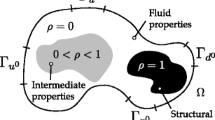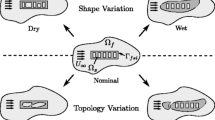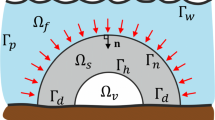Abstract
This paper introduces a topology optimization approach that combines an explicit level set method (LSM) and the extended finite element method (XFEM) for designing the internal structural layout of fluid-structure interaction (FSI) problems. The FSI response is predicted by a monolithic solver that couples an incompressible Navier-Stokes flow model with a small-deformation solid model. The fluid mesh is modeled as an elastic continuum that deforms with the structure. The fluid model is discretized with stabilized finite elements and the structural model by a generalized formulation of the XFEM. The nodal parameters of the discretized level set field are defined as explicit functions of the optimization variables. The optimization problem is solved by a nonlinear programming method. The LSM-XFEM approach is studied for two- and three-dimensional FSI problems at steady-state and compared against a density topology optimization approach. The numerical examples illustrate that the LSM-XFEM approach convergences to well-defined geometries even on coarse meshes, regardless of the choice of objective and constraints. In contrast, the density method requires refined grids and a mass penalization to yield smooth and crisp designs. The numerical studies show that the LSM-XFEM approach can suffer from a discontinuous evolution of the design in the optimization process as thin structural members disconnect. This issue is caused by the interpolation of the level set field and the inability to represent particular geometric configurations in the XFEM model. While this deficiency is generic to the LSM-XFEM approach used here, it is pronounced by the nonlinear response of FSI problems.

























Similar content being viewed by others
References
Allen M, Maute K (2002) Reliability based optimization of aeroelastic structures. In: Proceedings of the 9th AIAA/ISSMO Symposium on Multidisciplinary Analysis and Optimization, Atlanta, GA, September 4 – 6
Allen M, Maute K (2004) Reliability based optimization of aeroelastic structures. Struct Multidiscip Optim 24:228–242
Amestoy P, Duff I, L’Excellent JY (2000) Multifrontal parallel distributed symmetric and unsymmetric solvers. Comput Methods Appl Mech Eng 184(24):501–520
Angot P, Bruneau CH, Fabrie P (1999) A penalization method to take into account obstacles in incompressible viscous flows. Numer Math 81(4):497–520
Bendsøe M, Sigmund O (1999) Material interpolation schemes in topology optimization. Arch Appl Mech 69(9-10):635–654
Bourdin B (2001) Filters in topology optimization. Int J Numer Methods Eng 50(9):2143–2158
Brampton C, Kim HA, Cuningham J (2012) Level set topology optimisation of aircraft wing considering aerostructural interaction. In: 12th AIAA Aviation Technology, Integration, and Opterations (ATIO) Conference and 14th AIAA/ISSM Multidisciplinary Analysis and Optimization Conference, Indianapolis, IN, September 17–19
COMSOL (2008) Mems module model library: Fluid-structure interaction Tech. rep. COMSOL
van Dijk N, Maute K, Langelaar M, Keulen F (2013) Level-set methods for structural topology optimization: a review. Struct Multidiscip Optim pp 1–36
Dunning P, Stanford B, Kim H (2014) Coupled aerostructural topology optimization using a level set method for 3d aircraft wings. Structural and Multidisciplinary Optimization. doi:10.1007/s00158-014-1200-1
Gerstenberger A, Wall WA (2008) An extended finite element method/Lagrange multiplier based approach for fluid-structure interaction. Comput Methods Appl Mech Eng 197:1699–1714
Ghazlane I, Carrier G, Dumont A, Marcelet M, Désidéri J A (2011) Aerostructural optimization with the adjoint method. In: EUROGEN 2011, Capua, Italy, September 14 - 15
Gomes A A, Suleman A (2008) Topology optimization of a reinforced wing box for enhanced roll maneuvers. AIAA J 46:548– 556
Guest J (2009) Topology optimization with multiple phase projection. Comput Methods Appl Mech Eng 199 (1-4):123–135
Guo S (2007) Aeroelastic optimization of an aerobatic aircraft wing structure. Aerosp Sci Technol 11(5):396–404
Guo S, Cheng W, Cui D (2005) Optimization of composite wing structures for maximum flutter speed. In: 46th AIAA/ASME/ASCE/AHS/ASC Structures, Structural Dynamics & Materials Conference, Austin, TX, April 21 - 25
Hubner B, Walhorn E, Dinkler D (2004) A monolithic approach to fluid-structure interaction using space-time finite elements. Comput Methods Appl Mech Eng 193(23-26):2087–2104
Kennedy G, Kenway G, Martins J (2014) Towards gradient-based design optimization of flexible transport aircraft with flutter constraints. In: 15th AIAA/ISSMO Multidisciplinary Analysis and Optimization Conference, Atlanta,Georgia, June 16-20
Kreissl S, Maute K (2011) Topology optimization for unsteady flow. Int J Numer Methods Eng 87:1229–1253
Kreissl S, Maute K (2012) Levelset based fluid topology optimization using the extended finite element method. Struct Multidiscip Optim:1–16
Lang C, Makhija D, Doostan A, Maute K (2014) A simple and efficient preconditioning scheme for heaviside enriched xfem. Comput Mech 54(5):1357–1374
Makhija D, Maute K (2014a) Level set topology optimization of scalar transport problems. Struct Multidiscip Optim. pp 1–9
Makhija D, Maute K (2014b) Numerical instabilities in level set topology optimization with the extended finite element method. Struct Multidiscip Optim 49(2):185–197
Martins J, Alonso J, Reuther J (2005) A coupled-adjoint sensitivity analysis method for high-fidelity aero-structural design. Optim Eng 6(1):33–62
Maute K, Reich G (2006) Integrated multidisciplinary topology optimization approach to adaptive wing design. AIAA Journal of Aircraft 43(1):253–263
Maute K, Nikbay M, Farhat C (2003) Sensitivity analysis and design optimization of three-dimensional nonlinear aeroelastic systems by the adjoint method. Int J Numer Methods Eng 56(6):911–933
Petersson J, Sigmund O (1998) Slope constrained topology optimization. Int J Numer Methods Eng 41 (8):1417–1434
Saad Y (1994) Ilut: A dual threshold incomplete lu factorization. Numerical Linear Algebra Appl 1(4):387–402
Sala M, Stanley KS, Heroux MA (2008) On the design of interfaces to sparse direct solvers. ACM Trans Math Softw 34(2):9
Sigmund O (2007) Morphology-based black and white filters for topology optimization. Struct Multidiscip Optim 33(4-5):401–424
Sigmund O, Maute K (2012) Sensitivity filtering from a continuum mechanics perspective. Struct Multidiscip Optim 46(4):471–475
Sigmund O, Maute K (2013) Topology optimization approaches: A comparative review. Struct Multidiscip Optim 48(6):1031–1055
Stanford B (2008) Aeroelastic analysis and optimization of membrane micro air vehicle wings. PhD thesis, University of Florida
Stanford B, Beran P (2013) Aerothermoelastic topology optimization with flutter and buckling metrics. Struct Multidiscip Optim 48(1):149–171
Stanford B, Ifju P (2009) Aeroelastic topology optimization of membrane structures for micro air vehicles. Struct Multidiscip Optim 38(3):301–316
Stein K, Tezduyar TE, Benney R (2004) Automatic mesh update with the solid-extension mesh moving technique. Comput Methods Appl Mech Eng 193(21-22):2019–2032
Svanberg K (2002) A class of globally convergent optimization methods based on conservative convex separable approximations. SIAM J on Optim 12(2):555–573
Terada K, Asai M, Yamagishi M (2003) Finite cover method for linear and non-linear analyses of heterogeneous solids. Int J Numer Methods Eng 58(9):1321–1346
Tezduyar TE, Mittal S, Ray SE, Shih R (1992) Incompressible flow computations with stabilized bilinear and linear equal-order-interpolation velocity-pressure elements. Comput Methods Appl Mech Eng 95:221–242
Tran AB, Yvonnet J, He QC, Toulemonde C, Sanahuja J (2011) A multiple level set approach to prevent numerical artifacts in complex microstructures with nearby inclusions within xfem. Int J Numer Methods Eng 85(11):1436–1459
Villanueva CH, Maute K (2014) Density and level set-xfem schemes for topology optimization of 3-d structures. Comput Mech 54(1):133–150
Yoon GH (2009) Topology optimization for stationary fluid-structure interaction problems using a new monolithic formulation. Int J Numer Meth Engng 82:591–616
Yoon GH (2014) Stress-based topology optimization method for steady-state fluidstructure interaction problems. Comput Methods Appl Mech Eng 278:499–523
Zhou M, Rozvany G (1991) The COC algorithm, part II: topological, geometry and generalized shape optimization. Comput Methods Appl Mech Eng 89(1–3):309–336
Acknowledgements
The authors acknowledge the support of the National Science Foundation under grant CMMI 1235532. The opinions and conclusions presented in this paper are those of the authors and do not necessarily reflect the views of the sponsoring organization.
Author information
Authors and Affiliations
Corresponding author
Rights and permissions
About this article
Cite this article
Jenkins, N., Maute, K. Level set topology optimization of stationary fluid-structure interaction problems. Struct Multidisc Optim 52, 179–195 (2015). https://doi.org/10.1007/s00158-015-1229-9
Received:
Revised:
Accepted:
Published:
Issue Date:
DOI: https://doi.org/10.1007/s00158-015-1229-9




